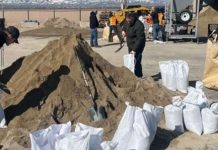May 28, 2019 (Accuweather/UPI) — Record-breaking floods continued to inundate riverside communities in the central United States on Monday. Evacuations were underway in several locations, and flood watches and warnings have been issued across Oklahoma, Kansas, Arkansas, Missouri, Illinois and parts of Nebraska and Iowa.
Flooded areas of Central states like Oklahoma and Arkansas are forecast to receive more rain in the coming days, increasing flooding risks along the already swollen rivers in the central United States.
“The very wet spring pattern in the Plains and Midwest will continue through at least midweek as two low pressure systems move across the area,” said AccuWeather meteorologist Ryan Adams.
As of midday on Monday, the low pressure was located in north-central Iowa, and it will continue to move northeastward. As it does, moderate to heavy rain will continue to fall to north of the low in northern Iowa, central and southern Minnesota, and much of Wisconsin. To the south of the low, strong to severe thunderstorms will be possible from eastern Iowa through northern Illinois and northern Indiana.
The second low pressure will move into Kansas on Tuesday, again unleashing heavy rain to the north of Iowa, as well as in central and southern Iowa and northern Missouri on Tuesday night.
“Severe weather will be possible from eastern Nebraska down through central Oklahoma. Some of these areas have been the wettest this month, with the second-wettest May on record in Wichita and third-wettest in Oklahoma City,” Adamson said. “A much-needed break in the rain should occur after Wednesday.”
Arkansas Gov. Asa Hutchinson declared a state of emergency on Friday. The U.S. Army Corps of Engineers is warning Arkansans about the possibility of historic flooding along the Arkansas River.
Oklahoma Gov. Kevin Stitt has also addressed the historic flooding in the state. On Friday, Stitt amended an executive order to declare a state of emergency for all 77 Oklahoma counties impacted by flooding and severe storms.
Stitt first signed the executive order earlier in the month on May 1 for 52 counties, and he later amended it on May 8 to include 14 more counties. The most recent amendment stretches farther across the state, as severe weather and heavy rainfall has continued.
The city of Tulsa was among the flooded cities on Monday. Tulsa continues to flood as the swollen Arkansas River rises. Tulsa County officials say some residents west of the city have already evacuated their homes due to flooding. Several roads along the river are closed, and local officials urge residents to follow the proper safety precautions when traveling.
On Monday evening, the Tulsa police closed parts of Riverside Drive due to flooding. Riverside also remains closed in both directions north of Denver Ave. There are no plans to close Riverside between 31st and 51st.
“Please stay away from these areas,” the City of Tulsa said in a tweet.
The floodwaters were projected to crest Monday at more than 23 feet in Tulsa, near the record 25.21 feet set in 1986. The National Weather Service latest measurement was 22.81 feet at 5:30 p.m. CDT.
The Army Corps of Engineers released 250,000 cubic feet of water per second from Keystone Dam, located near Tulsa, into the Arkansas River early in the weekend. However, heavy rainfall above the dam led to two increased releases from the dam. The corps increased the floodwaters released to 265,000 cubic feet per second at 7 p.m, local time, on Sunday and then to 275,000 cubic feet per second at 7 a.m, local time, on Monday.
Due to the additional release at the Keystone Dam, floodwater is steadily rising and residents and businesses along the Arkansas River need to heed all warnings and take precautions.
“The Arkansas River is expected to rise 6 to 9 inches in Tulsa. The City of Tulsa believes that there will be no significant additional impacts,” the Tulsa District, U.S. Army Corps of Engineers, said in a Facebook post on Sunday.
The Oklahoma National Guard continued to patrol local levees on Memorial Day. Oklahoma Guardsmen filled and loaded sandbags on Saturday, May 25, in response to expected increased flooding in the Tulsa area.
Other locations along the Arkansas River also continue to flood. Several locations are expected to crest later this week, according to the NWS.
The Arkansas River levels at Van Buren, near Fort Smith, Ark., broke the previous water level record of 38.1 feet, which was set in 1945. By 5 p.m. CDT on Sunday, the water levels reached 38.3 feet. The National Weather Service predicts the river will crest about 4 feet above this record at 42.5 feet on Tuesday.
The flood gauge near Ponca City, Oklahoma, on the Arkansas River crested at 22.26 feet on Friday, breaking the 1993 record of 20.11 feet.
According to AccuWeather meteorologist Kristina Pydynowski, there are rainfall estimates of over 8 inches in the last seven days across northeastern Oklahoma, southwestern Missouri and southeastern Kansas.
“So far this month, nearly 12 inches of rain has soaked Tulsa, Okla. The city averages nearly 6 inches for the entire month,” Pydynowski said.
Wichita, Kan., has also measured nearly 12 inches of rain so far this May, according to Pydynowski.
“The additional rain on Memorial Day and then again on Tuesday can make this month the wettest May, beating May 2008 and its 13.14 inches, and the all-time wettest month, surpassing June 1923 and its 14.43 inches,” Pydynowski said.
All residents should stay out of the water, adhere to traffic diversions, and maintain a close watch on children. The Tulsa Police Department has already had to remove people from the areas along the Arkansas River.
“Turn around, don’t drown,” local officials warn.







